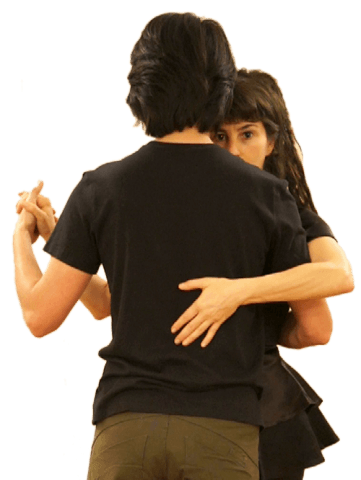{Please note that this post represents very new theory, and is absolutely still in process. I reserve the right to revise my analysis.}
Dancers explore many parts of ourselves, the world, and relationships through tango. One journey which especially interests me is the journey about gender.
A very special part of my work is gently drawing out my students’ masculinity, showing them how to inhabit their bodies with confidence and power and practicing approaching a woman with strength. These days most men are afraid to show any strength because they don’t want to appear dominating or aggressive. Tango is about finding pleasure and power in a non-violent strength of their bodies and to use this to show tenderness and connection, to be elegant, to create dynamic motion, and to express themselves.
Prowess and the Princess
 I have days, and tilts of the head, when I think that tango is very healthy, for psychology, community, gender development, and relationships. Other days when I think it allows people to develop and indulge in the worst of competition, defenses, superficiality, and abuse.
I have days, and tilts of the head, when I think that tango is very healthy, for psychology, community, gender development, and relationships. Other days when I think it allows people to develop and indulge in the worst of competition, defenses, superficiality, and abuse.
Fortunately, today is the former type of day. As I sat contemplating at my “receiving a blogpost” coordinates, I wrote something about helping men find their masculinity but not becoming like Mr.E. And then I paused. I happen to be reading a book about rites of passage. It’s unclear which aspects of such rites are relevant for today, and I’m skeptical about mother-complexes and the like. But it’s easy to see that we have lost track of any supportive structures for human development, which bring wisdom of eldors and love of community to support individuals in relating to society, roles, and the meaning of life.
And with this perspective I came to wonder if perhaps, despite my disgust at Mr.E’s girl-of-the-week behavior, maybe that’s something men need to get to and go through. Maybe what the modern man needs is to prove he can indeed seduce any woman. And only after that can he make a free choice to be with A woman. Every man I know well has had a freak-out at the moment of monogamous commitment – he feels unsure about the whole fidelity enterprise. Heterosexual men are battered with expectations of virility which serial monogamy never quite proves. They may well be with the right woman, but they doubt. Perhaps it is not her who they doubt, but themselves. They want to manifest their power fully, so they feel masterful, rather than helpless in the final choice. Tango gives men the chance to find their sexual prowess fully.
{A big screaming problem here is what about the women whose poor hearts Mr.E manipulates to prove his mastery? Some say that they too are interested in casual encounters. I have my doubts. As much as men are bullied into virility, for women a convincing act of tenderness evokes a wedding. Perhaps this should be a standard part of the social tango education teachers provide: use the cabeceo, don’t apply cologne, and wear a condom on your heart.}
I’ve idly considered teaching seminars about masculinity using tango as a medium. Today I wondered – why only masculinity?
There’s more for women to learn from tango besides how to walk well in high heels.
I tend to think access to their ballerina-princess fantasy doesn’t require a lot of training.
But the oracle was on a rampage today, and she kept the beam transmitting well into my second Röststätte latte macchiato.
The thing is, social science statistics tell us that beyond the wedding women tend to be disappointed. (Men tend to be content.) So personal satisfaction for men and women requires getting beyond “fucking all night”, “getting lots of girls”, and “falling in love and getting married”. Even though we are surrounded with evidence that it’s more complicated, what gender identity, archetypes, and skills do we need to pass through the cultural myths?
Creativity
I want to try to find a story of tango as a liberatory gender journey. For men, from fear of their own strength, through sexual prowess, to the decision to choose, to then something much more important than sex, which is creativity. I realize that very men who I dance with are far from touching this. And I feel that when it first appears, they have no idea what to do with it.
Since creativity is what I serve as a Revel, I have no interest in commanding a dance from anyone. I always use the cabeceo and will only ask a man to dance if I want to Mark him.
For women, the journey from inadequate object, to perfect femininity, and out the other side, beyond seduction and competition to a deeper power. Tangueras do step down from that throne. After luxuriating in men’s desire, we reach a point of realizing we don’t actually want most of them, and very well none of them. Walking away from a room of men who want you is another kind of feminine power. Where it gets interesting is when a dancer loves tango enough to find a way to stay.
What is there beyond the gender fantasies and the interrupted conversations that never quite add up to friendship? Dancing. Art. Finding a way to be creative. For some women this may mean that she learns to mark.
Queer theory tells us that we all have masculinity and femininity within us, and that we choose expressive locations along a continuum. What I have come to believe through the experience of tango is that the essence of masculinity is creativity. Tango has given me my woman and my man, my ballerina-fairy-princess and my driving creativity. Finally, the butch who all my life kept showing up (with her motorcycle and free weights) can manifest in a satisfying way. I do not experience tango as androgynous. I do not like to change roles while dancing. I prefer to dance a whole tanda as a man or as a woman.
I do not believe that beyond the gender fantasies is a dance in which both parties contribute creativity at the same time. (That’s contact improvisation, please go do it if that’s what you want. You’ll need more space.)
In fact I believe that tango’s unique contribution to human culture and development is a profound experience of these roles. The question before us is how to make that experience a liberatory one which takes us closer to our souls?
Courage
So if the essence of the mark/masculine role is creativity? What is the essence of the revel’s femininity? For some time I have considered femininity asthe harder question (in and out of tango). Partly because it has been overfilled with essentialist detritus that we cannot easily disentangle from various cultures’ degrading formations.
My most powerful experiences of tango happened when I felt my mark’s creativity surge forth. My movement set him free. I witnessed and accompanied him. Crucial to this way of dancing is my strength. He cannot hold me up and also be free to move. I have to take care of my own body. And I cannot be afraid.
Fear is a difficult topic. I lost one of my best friends trying to talk about it. Very much problematic male behavior comes from fear, or fear of fear. In some ways men have more to fear than women – especially failure and shame. These are not such potent problems for women. For us, what is to fear is pain. And women after some years of unavoidable interactions with pain pass through fear. A man may never pass through fear of shame. He may avoid it, or may be permanently wounded by it. Men often manage fear of shame with anger. If you stay on the offensive, nothing can get to you. With or without offensive protections, it never becomes ok for a man to be shamed. Whereas most of what a woman fears is unavoidable.
I reject the idea that the act of giving birth is a central defining feature of femininity – except insofar as we are designed to withstand pain. Whether or not they have given birth, women develop the capacity to survive and accompany pain, emotion, and complexity in general. I have learned to survive and accompany anger. In fact I might say that despite all I have done in my life, this has been the biggest -and still not fully vanquished- challenge. As a dancer I know it is my fearlessness which sets men free. Some release their power into this experience within a few moments of sensing it. For me, it feels like dancing with something that is exploding with brilliance.
Not all men are ready for this. Some respond by gripping me, forcing a dependence that I do not need. Some describe the physical sensation by saying “wow, you have a lot of power”. They do not dare to criticize this, but they are clearly not enjoying it. (These guys are still in the prowess phase.)
Men’s anger is not only an offense against the threat of shame. Outrage is a totally appropriate and necessary response to the violence and injustice of the world and the wounds of life. The question is what to do with this anger, and there are many answers. One answer is art. Tango is often acknowledged as a sink or ground or vessel for pain and grief and loss. It is less often recognized as a place for anger -perhaps because the expression of anger is too risky in Argentine culture (see “A Passing Embrace” and “Right, wrong and handsome”). But world-historically, very much great art is forged in the crucible of men’s emotions. Art gives men permission to experience rage. I want to give this permission to my dance partners, because this is one profound source of creativity.
My role is not to interpret him, but to set him free. And it is my capacity to quite literally step into the unknown without the slightest hesitation which makes this possible.














